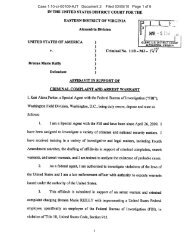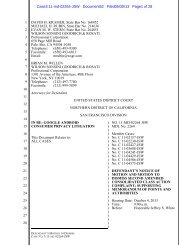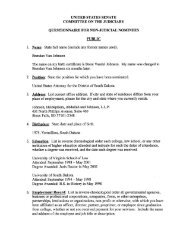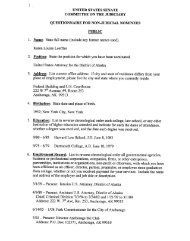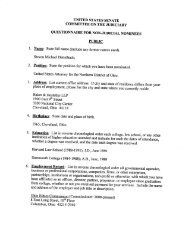Government Response to Defense Motion on Jury ... - Main Justice
Government Response to Defense Motion on Jury ... - Main Justice
Government Response to Defense Motion on Jury ... - Main Justice
You also want an ePaper? Increase the reach of your titles
YUMPU automatically turns print PDFs into web optimized ePapers that Google loves.
Case 1:08-cr-00274-ESH Document 194 Filed 10/14/10 Page 1 of 15UNITED STATES DISTRICT COURTFOR THE DISTRICT OF COLUMBIAUNITED STATES OF AMERICA ))v. )) No. 1:08-cr-00274-ESHKEVIN A. RING, ))Defendant. ))UNITED STATES’ REPLY IN SUPPORT OF ITS MOTION TO MODIFYINSTRUCTION ON CAMPAIGN CONTRIBUTIONS AND OPPOSITION TOCROSS-MOTION TO DISMISS INDICTMENTThe United States, through its undersigned at<str<strong>on</strong>g>to</str<strong>on</strong>g>rneys, respectfully submits this reply insupport of its moti<strong>on</strong> <str<strong>on</strong>g>to</str<strong>on</strong>g> modify the instructi<strong>on</strong> <strong>on</strong> campaign c<strong>on</strong>tributi<strong>on</strong>s and this oppositi<strong>on</strong> <str<strong>on</strong>g>to</str<strong>on</strong>g>defendant Ring’s cross-moti<strong>on</strong> <str<strong>on</strong>g>to</str<strong>on</strong>g> dismiss the Indictment. Defendant Ring misrepresents the<str<strong>on</strong>g>Government</str<strong>on</strong>g>’s modest request for a change in the jury instructi<strong>on</strong>s—a change that simplycorrects the current instructi<strong>on</strong>’s legal defect by inserting language taken directly from theSupreme Court’s holding in McCormick v. United States, 500 U.S. 257 (1991). Defendant Ringalso cross-moves <str<strong>on</strong>g>to</str<strong>on</strong>g> dismiss the Indictment based <strong>on</strong> a mischaracterizati<strong>on</strong> of the <str<strong>on</strong>g>Government</str<strong>on</strong>g>’srepresentati<strong>on</strong>s in its moti<strong>on</strong>. Not c<strong>on</strong>tent with his previous unsuccessful attempts <str<strong>on</strong>g>to</str<strong>on</strong>g> dismiss theIndictment, defendant Ring pursues yet another creative, but ultimately untenable, argument <str<strong>on</strong>g>to</str<strong>on</strong>g>avoid trial. See, e.g., Dkt. Nos. 143 & 155. Defendant Ring’s cross-moti<strong>on</strong> <str<strong>on</strong>g>to</str<strong>on</strong>g> dismiss should bedenied, and the <str<strong>on</strong>g>Government</str<strong>on</strong>g>’s modest request <str<strong>on</strong>g>to</str<strong>on</strong>g> modify the current instructi<strong>on</strong> <str<strong>on</strong>g>to</str<strong>on</strong>g> be c<strong>on</strong>sistentwith Supreme Court precedent should be granted.
Case 1:08-cr-00274-ESH Document 194 Filed 10/14/10 Page 2 of 15I. The <str<strong>on</strong>g>Government</str<strong>on</strong>g>’s Request <str<strong>on</strong>g>to</str<strong>on</strong>g> Insert Language Taken Directly from McCormickShould be GrantedDefendant Ring opposes the <str<strong>on</strong>g>Government</str<strong>on</strong>g>’s request <str<strong>on</strong>g>to</str<strong>on</strong>g> correct the legally deficient juryinstructi<strong>on</strong>s with what should be a n<strong>on</strong>-c<strong>on</strong>troversial remedy—the Supreme Court’s own words.More specifically, defendant Ring asserts that “[t]he Court’s campaign c<strong>on</strong>tributi<strong>on</strong> instructi<strong>on</strong>remains correct as a matter of law” because “[m]uch of its language is drawn directly fromSupreme Court and D.C. Circuit cases . . . .” Dkt. No. 190 at p. 9. It may be true that much ofthe Court’s current instructi<strong>on</strong> was drawn directly from Supreme Court and D.C. Circuit cases,but, more importantly, it omits the most material secti<strong>on</strong> from the Supreme Court’s seminalholding <strong>on</strong> this issue. The <str<strong>on</strong>g>Government</str<strong>on</strong>g>’s modest request <str<strong>on</strong>g>to</str<strong>on</strong>g> modify the jury instructi<strong>on</strong>s merelyproposes <str<strong>on</strong>g>to</str<strong>on</strong>g> correct the current instructi<strong>on</strong>’s legal defect by quoting directly from the SupremeCourt’s holding in McCormick.A. The <str<strong>on</strong>g>Government</str<strong>on</strong>g>’s Proposed Correcti<strong>on</strong> is Modest and Legally RequiredAs currently formulated, the jury instructi<strong>on</strong>s do not provide an accurate statement of thelaw. The <str<strong>on</strong>g>Government</str<strong>on</strong>g> has an <strong>on</strong>going obligati<strong>on</strong> <str<strong>on</strong>g>to</str<strong>on</strong>g> inform the Court of any legal deficiencies inits instructi<strong>on</strong>s <str<strong>on</strong>g>to</str<strong>on</strong>g> the jury that could mislead the public or could be cited incorrectly as legalprecedent and, c<strong>on</strong>sequently, filed its moti<strong>on</strong> <str<strong>on</strong>g>to</str<strong>on</strong>g> modify the jury instructi<strong>on</strong>s in furtherance ofthat obligati<strong>on</strong>.The Supreme Court specifically stated in McCormick that campaign c<strong>on</strong>tributi<strong>on</strong>s canc<strong>on</strong>stitute an illicit thing of value “if the payments are made in return for an explicit promise orundertaking by the official <str<strong>on</strong>g>to</str<strong>on</strong>g> perform or not <str<strong>on</strong>g>to</str<strong>on</strong>g> perform an official act.” McCormick, 500 U.S. at273. To the extent that the Court’s previous jury instructi<strong>on</strong>s did not reflect the Supreme Court’sruling, they failed <str<strong>on</strong>g>to</str<strong>on</strong>g> provide a complete picture of the legal status of campaign c<strong>on</strong>tributi<strong>on</strong>s.2
Case 1:08-cr-00274-ESH Document 194 Filed 10/14/10 Page 3 of 15Indeed, the previous jury instructi<strong>on</strong>s go so far as <str<strong>on</strong>g>to</str<strong>on</strong>g> state that “campaign c<strong>on</strong>tributi<strong>on</strong>s areperfectly legal and protected”—a statement in direct c<strong>on</strong>tradicti<strong>on</strong> with the Supreme Court’sdeclarati<strong>on</strong> that “[t]his is not <str<strong>on</strong>g>to</str<strong>on</strong>g> say that it is impossible for an elected official <str<strong>on</strong>g>to</str<strong>on</strong>g> commitex<str<strong>on</strong>g>to</str<strong>on</strong>g>rti<strong>on</strong> in the course of financing an electi<strong>on</strong> campaign.” McCormick, 500 U.S. at 273. Theprevious instructi<strong>on</strong> is legally inaccurate, misleads the jury, and establishes a deficient precedentthat other courts may rely up<strong>on</strong> in similar cases. The <str<strong>on</strong>g>Government</str<strong>on</strong>g>’s proposed jury instructi<strong>on</strong>specifically quotes from McCormick in an effort <str<strong>on</strong>g>to</str<strong>on</strong>g> accurately describe the legal status ofcampaign c<strong>on</strong>tributi<strong>on</strong>s as they relate <str<strong>on</strong>g>to</str<strong>on</strong>g> bribery.The <str<strong>on</strong>g>Government</str<strong>on</strong>g>’s proposed jury instructi<strong>on</strong> preserves the entire first paragraph of theinstructi<strong>on</strong> as well as all the language explaining that lobbyists’ acti<strong>on</strong>s are often legal andappropriate. It directs the jury not <str<strong>on</strong>g>to</str<strong>on</strong>g> “c<strong>on</strong>sider campaign c<strong>on</strong>tributi<strong>on</strong>s or fundraisers provided<str<strong>on</strong>g>to</str<strong>on</strong>g> be an illegal gratuity <str<strong>on</strong>g>to</str<strong>on</strong>g> certain public officials.” Dkt. No. 188 at p. 4. It merely adds <strong>on</strong>esentence that provides an accurate and complete representati<strong>on</strong> of the law quoted directly fromMcCormick: “[Y]ou may c<strong>on</strong>sider campaign c<strong>on</strong>tributi<strong>on</strong>s or fundraisers as part of the stream ofthings of value provided <str<strong>on</strong>g>to</str<strong>on</strong>g> public officials if the payment is made in return for an explicitpromise or undertaking by the official <str<strong>on</strong>g>to</str<strong>on</strong>g> perform or not <str<strong>on</strong>g>to</str<strong>on</strong>g> perform an official act.” Dkt. No.188 at p. 4 (emphasis added; emphasized porti<strong>on</strong> quoted from McCormick). Adding this modestchange <str<strong>on</strong>g>to</str<strong>on</strong>g> the jury instructi<strong>on</strong>s ensures that the jury is properly instructed and will not return averdict based <strong>on</strong> a misunderstanding of the law. The <str<strong>on</strong>g>Government</str<strong>on</strong>g> is, of course, open <str<strong>on</strong>g>to</str<strong>on</strong>g>additi<strong>on</strong>al changes <str<strong>on</strong>g>to</str<strong>on</strong>g> the instructi<strong>on</strong> <str<strong>on</strong>g>to</str<strong>on</strong>g> ensure that the legal instructi<strong>on</strong>s are complete andaccurate. What the <str<strong>on</strong>g>Government</str<strong>on</strong>g> cannot accept is an incomplete and inaccurate recitati<strong>on</strong> of the3
Case 1:08-cr-00274-ESH Document 194 Filed 10/14/10 Page 4 of 15law that may c<strong>on</strong>fuse the jurors, the public, or the testifying witnesses. 1It should not go unnoticed that defendant Ring’s resp<strong>on</strong>se here is part of a l<strong>on</strong>g-standingattempt <str<strong>on</strong>g>to</str<strong>on</strong>g> minimize the impact of campaign c<strong>on</strong>tributi<strong>on</strong>s in this matter. As far back asSeptember 2009, this Court rejected defendant Ring’s attempt <str<strong>on</strong>g>to</str<strong>on</strong>g> improperly instruct the jury <str<strong>on</strong>g>to</str<strong>on</strong>g>acquit him “if [it] find[s] that acts in the indictment were taken because of Mr. Ring’sparticipati<strong>on</strong> in or c<strong>on</strong>necti<strong>on</strong> <str<strong>on</strong>g>to</str<strong>on</strong>g> campaign c<strong>on</strong>tributi<strong>on</strong>s or fundraisers, you must acquit him <strong>on</strong>charges arising out of those acts.” Dkt. No. 84 at p. 4 (defendant Ring’s proposed juryinstructi<strong>on</strong>s). Similarly, this Court should resist defendant Ring’s reliance <strong>on</strong> another legallydeficient instructi<strong>on</strong> and reject his attempt <str<strong>on</strong>g>to</str<strong>on</strong>g> impede the <str<strong>on</strong>g>Government</str<strong>on</strong>g>’s modest efforts <str<strong>on</strong>g>to</str<strong>on</strong>g> correctthat instructi<strong>on</strong> with the Supreme Court’s own words.B. Correcting the Instructi<strong>on</strong> <str<strong>on</strong>g>to</str<strong>on</strong>g> Comply with McCormick Will Not Alter the CaseThis <str<strong>on</strong>g>Government</str<strong>on</strong>g>’s proposed correcti<strong>on</strong> <str<strong>on</strong>g>to</str<strong>on</strong>g> the legally deficient jury instructi<strong>on</strong>s will not1 The <str<strong>on</strong>g>Government</str<strong>on</strong>g> acknowledges that its change in positi<strong>on</strong> occurred after Mr. Albaugh’sstatements regarding campaign c<strong>on</strong>tributi<strong>on</strong>s, discussed in Exhibit 1 of Docket Entry 187. Asdefendant Ring notes, Mr. Albaugh heard at trial that all campaign c<strong>on</strong>tributi<strong>on</strong>s were “perfectlylegal and appropriate.” Dkt. No. 187 at p. 4. Unfortunately, the instructi<strong>on</strong> Mr. Albaugh heardrepeatedly does not accurately reflect the state of the law of campaign c<strong>on</strong>tributi<strong>on</strong>s as discussedin McCormick. Yet, Mr. Albaugh pleaded guilty <str<strong>on</strong>g>to</str<strong>on</strong>g> an informati<strong>on</strong> charging him with receivingboth campaign c<strong>on</strong>tributi<strong>on</strong>s as well as meals and tickets as part of the stream of things of value“in exchange for” his performance of official acts. Dkt. No. 1 at p. 5 13 (United States v.Albaugh, 08-cr-157-ESH). Although he testified at trial c<strong>on</strong>sistently with his factual basis, as the<str<strong>on</strong>g>Government</str<strong>on</strong>g> disclosed <str<strong>on</strong>g>to</str<strong>on</strong>g> the Defendant <strong>on</strong> September 28, Mr. Albaugh now has stated that hedid not take any official acts because of the meals and tickets, but <strong>on</strong>ly because of the receipt ofcampaign c<strong>on</strong>tributi<strong>on</strong>s. The <str<strong>on</strong>g>Government</str<strong>on</strong>g> is not opining <strong>on</strong> Mr. Albaugh’s motivati<strong>on</strong>s inmaking these statements, but Ring implies that Mr. Albaugh’s rejecti<strong>on</strong> of his prior testim<strong>on</strong>ymay have been influenced by the repetiti<strong>on</strong> that campaign c<strong>on</strong>tributi<strong>on</strong>s were legal andappropriate. As explained in the <str<strong>on</strong>g>Government</str<strong>on</strong>g>’s moti<strong>on</strong> <str<strong>on</strong>g>to</str<strong>on</strong>g> rec<strong>on</strong>sider the jury instructi<strong>on</strong>s, theinstructi<strong>on</strong> as provided <str<strong>on</strong>g>to</str<strong>on</strong>g> the jury and heard repeatedly by Mr. Albaugh is an incorrect statemen<str<strong>on</strong>g>to</str<strong>on</strong>g>f law.4
Case 1:08-cr-00274-ESH Document 194 Filed 10/14/10 Page 5 of 15alter the presentati<strong>on</strong> of evidence. In fact, the <str<strong>on</strong>g>Government</str<strong>on</strong>g> intends <str<strong>on</strong>g>to</str<strong>on</strong>g> present fewer exhibitsabout campaign c<strong>on</strong>tributi<strong>on</strong>s and fundraising in its case-in-chief than it did during the first trial.The <str<strong>on</strong>g>Government</str<strong>on</strong>g> does not anticipate introducing any new witnesses in its case-in-chief orintroducing any new exhibits during its direct examinati<strong>on</strong>s. The <str<strong>on</strong>g>Government</str<strong>on</strong>g> also does notanticipate lengthening the trial in any way. The <strong>on</strong>ly change will be providing a legally correctjury instructi<strong>on</strong> instead of an instructi<strong>on</strong> that c<strong>on</strong>travenes the Supreme Court’s holding inMcCormick.In support of his oppositi<strong>on</strong>, defendant Ring asserts that “[t]hroughout its entire pleading,the government fails <str<strong>on</strong>g>to</str<strong>on</strong>g> acknowledge that it has no evidence of an explicit quid pro quo inrelati<strong>on</strong> <str<strong>on</strong>g>to</str<strong>on</strong>g> campaign c<strong>on</strong>tributi<strong>on</strong>s and has repeatedly c<strong>on</strong>ceded as much . . . .” Dkt. No. 190 atpp. 9-10. The <str<strong>on</strong>g>Government</str<strong>on</strong>g> has c<strong>on</strong>ceded no such thing. During trial, the <str<strong>on</strong>g>Government</str<strong>on</strong>g> noted thatsome of the campaign c<strong>on</strong>tributi<strong>on</strong>s were quid pro quos, but chose not <str<strong>on</strong>g>to</str<strong>on</strong>g> argue the legal impac<str<strong>on</strong>g>to</str<strong>on</strong>g>f those in the last trial. See, e.g., Tr. Sept. 16, 2009 at p. 13 (“[I]n some situati<strong>on</strong>s in this casethere was a quid pro quo for campaign c<strong>on</strong>tributi<strong>on</strong>s.”). Defendant Ring will certainly argue <str<strong>on</strong>g>to</str<strong>on</strong>g>the jury that the <str<strong>on</strong>g>Government</str<strong>on</strong>g> has presented no evidence of an explicit quid pro quo, butdefendant Ring’s self-serving pretrial assessment of the <str<strong>on</strong>g>Government</str<strong>on</strong>g>’s evidence is not asufficient basis <str<strong>on</strong>g>to</str<strong>on</strong>g> charge the jury with an improper instructi<strong>on</strong>. 2 Tr. Sept. 22, 2009 at pp. 85-86.As noted in the <str<strong>on</strong>g>Government</str<strong>on</strong>g>’s <str<strong>on</strong>g>Moti<strong>on</strong></str<strong>on</strong>g>, matters of intent, such as whether a particular campaignc<strong>on</strong>tributi<strong>on</strong> was provided as part of an explicit quid pro quo, are decided by the jury. See2For example, during the last trial, Mr. Boulanger testified about defendant Ring’sstatement “hello quid, where’s the pro quo,” which defendant Ring argued applied <strong>on</strong>ly <str<strong>on</strong>g>to</str<strong>on</strong>g>campaign c<strong>on</strong>tributi<strong>on</strong>s, even though Mr. Boulanger testified that it applied <str<strong>on</strong>g>to</str<strong>on</strong>g> both campaignc<strong>on</strong>tributi<strong>on</strong>s and other things of value.5
Case 1:08-cr-00274-ESH Document 194 Filed 10/14/10 Page 6 of 15McCormick, 500 U.S. at 270 (“It goes without saying that matters of intent are for the jury <str<strong>on</strong>g>to</str<strong>on</strong>g>c<strong>on</strong>sider.”). The role of the Court is <str<strong>on</strong>g>to</str<strong>on</strong>g> properly instruct them.The <str<strong>on</strong>g>Government</str<strong>on</strong>g>’s moti<strong>on</strong> <str<strong>on</strong>g>to</str<strong>on</strong>g> amend the jury instructi<strong>on</strong>s (and the proposed instructi<strong>on</strong>itself) is strikingly modest in comparis<strong>on</strong> <str<strong>on</strong>g>to</str<strong>on</strong>g> defendant Ring’s cross-moti<strong>on</strong> <str<strong>on</strong>g>to</str<strong>on</strong>g> dismiss theIndictment. The <str<strong>on</strong>g>Government</str<strong>on</strong>g> does not make any new factual representati<strong>on</strong>s, quotes directlyfrom the Indictment and from McCormick, and expressly qualifies that campaign c<strong>on</strong>tributi<strong>on</strong>scould <strong>on</strong>ly be c<strong>on</strong>sidered as part of an explicit quid pro quo, not an illegal gratuity. It is unclearhow correcting the defect in the current instructi<strong>on</strong> by quoting directly from McCormick couldbe objecti<strong>on</strong>able. See Dkt. No. 190 at p. 8 n.3.Furthermore, this trial c<strong>on</strong>stitutes a different, and separate, proceeding than the last <strong>on</strong>e.When the <str<strong>on</strong>g>Government</str<strong>on</strong>g> tries a defendant following a mistrial, it may adjust its approach <str<strong>on</strong>g>to</str<strong>on</strong>g> thecase in resp<strong>on</strong>se <str<strong>on</strong>g>to</str<strong>on</strong>g> the mistakes of the first trial or <str<strong>on</strong>g>to</str<strong>on</strong>g> reflect new informati<strong>on</strong> that has come <str<strong>on</strong>g>to</str<strong>on</strong>g>light in the interim. See United States v. Poole, 407 F.3d 767, 773-77 (6th Cir. 2005) (notingthat prosecu<str<strong>on</strong>g>to</str<strong>on</strong>g>rs may add additi<strong>on</strong>al charges and develop new trial strategy in anticipati<strong>on</strong> of aretrial); United States v. Motley, 655 F.2d 186, 190 (9th Cir. 1982) (“Here . . . we have a simplecase of a prosecu<str<strong>on</strong>g>to</str<strong>on</strong>g>r doing what every trial lawyer tries <str<strong>on</strong>g>to</str<strong>on</strong>g> do: improve his chances of winning <strong>on</strong>retrial by learning from his mistakes at the original trial.”). As described in its <str<strong>on</strong>g>Moti<strong>on</strong></str<strong>on</strong>g>, the<str<strong>on</strong>g>Government</str<strong>on</strong>g>’s positi<strong>on</strong> clarifying the appropriate legal standard as set forth in McCormick alsomakes perfect sense in light of the Supreme Court’s decisi<strong>on</strong> in Skilling v. United States, 130S.Ct. 2896 (2010), which held that 18 U.S.C. § 1346 is “[i]nterpreted <str<strong>on</strong>g>to</str<strong>on</strong>g> encompass <strong>on</strong>ly briberyand kickback schemes.” Id. at 2933.Therefore, the <str<strong>on</strong>g>Government</str<strong>on</strong>g> respectfully requests that the Court correct the legal defect in6
Case 1:08-cr-00274-ESH Document 194 Filed 10/14/10 Page 8 of 15U.S. 359, 363 (1956); see also United States v. Rostenkowski, 59 F.3d 1291, 1298 (D.C. Cir.1995) (citing Costello with approval). Although “an indictment obtained in violati<strong>on</strong> offederal c<strong>on</strong>stituti<strong>on</strong>al rights must be dismissed, at least where substantial prejudice resulted,”J<strong>on</strong>es v. United States, 342 F.2d 863, 871-72 (D.C. Cir. 1964), there exists a “presumpti<strong>on</strong> ofregularity which attaches <str<strong>on</strong>g>to</str<strong>on</strong>g> Grand <strong>Jury</strong> proceedings,” Hamling v. United States, 418 U.S. 87,139 n.23 (1974).B. An Improper Instructi<strong>on</strong> <str<strong>on</strong>g>to</str<strong>on</strong>g> the Grand <strong>Jury</strong> is Insufficient <str<strong>on</strong>g>to</str<strong>on</strong>g> Dismiss a FaciallyValid IndictmentAs the Court has previously found in rejecting the renewed moti<strong>on</strong> for judgment ofacquittal, the <str<strong>on</strong>g>Government</str<strong>on</strong>g> presented sufficient evidence at trial for a finder of fact <str<strong>on</strong>g>to</str<strong>on</strong>g> c<strong>on</strong>victdefendant Ring of bribery h<strong>on</strong>est services fraud. The Court’s ruling makes plain that theIndictment is facially valid and adequately charges defendant Ring with bribery h<strong>on</strong>est servicesfraud. C<strong>on</strong>trary <str<strong>on</strong>g>to</str<strong>on</strong>g> defendant Ring’s asserti<strong>on</strong>, neither the wording of the Indictment nor the<str<strong>on</strong>g>Government</str<strong>on</strong>g>’s request <str<strong>on</strong>g>to</str<strong>on</strong>g> insert language in<str<strong>on</strong>g>to</str<strong>on</strong>g> the jury instructi<strong>on</strong>s, which is taken directly fromthe Supreme Court’s holding in McCormick, required the grand jury <str<strong>on</strong>g>to</str<strong>on</strong>g> have inappropriatelyc<strong>on</strong>sidered campaign c<strong>on</strong>tributi<strong>on</strong>s without finding an explicit quid pro quo.Courts generally have refused <str<strong>on</strong>g>to</str<strong>on</strong>g> review the adequacy of an indictment based <strong>on</strong> allegederrors in the legal instructi<strong>on</strong>s provided <str<strong>on</strong>g>to</str<strong>on</strong>g> the grand jury. See, e.g., United States v. Zangger,848 F.2d 923, 925 (8 th Cir. 1988) (“The prosecu<str<strong>on</strong>g>to</str<strong>on</strong>g>r is under no obligati<strong>on</strong> <str<strong>on</strong>g>to</str<strong>on</strong>g> give the grand jurylegal instructi<strong>on</strong>s.”); United States v. Buchanan, 787 F.2d 477, 487 (10 th Cir. 1986), cert. denied,494 U.S. 1088 (1990) (“Challenges going <strong>on</strong>ly <str<strong>on</strong>g>to</str<strong>on</strong>g> the instructi<strong>on</strong>s given <str<strong>on</strong>g>to</str<strong>on</strong>g> the grand jury as <str<strong>on</strong>g>to</str<strong>on</strong>g>the elements of the offenses are not grounds for dismissal of an indictment that is valid <strong>on</strong> itsface.”). Courts in this District and elsewhere have found that speculati<strong>on</strong> regarding improper8
Case 1:08-cr-00274-ESH Document 194 Filed 10/14/10 Page 9 of 15instructi<strong>on</strong> is not sufficient <str<strong>on</strong>g>to</str<strong>on</strong>g> establish dismissal of the indictment. See, e.g., United States v.Trie, 23 F. Supp. 2d 55, 62 (D.D.C. 1998) (ruling that although “c<strong>on</strong>ceivable that the grand jurywas not instructed [properly about FECA violati<strong>on</strong>s] . . . the mere suspici<strong>on</strong> that the grand jurymay not have been properly instructed with respect <str<strong>on</strong>g>to</str<strong>on</strong>g> the legal definiti<strong>on</strong> of c<strong>on</strong>tributi<strong>on</strong> isinsufficient <str<strong>on</strong>g>to</str<strong>on</strong>g> establish that [defendant] is entitled either <str<strong>on</strong>g>to</str<strong>on</strong>g> dismissal of the indictment or <str<strong>on</strong>g>to</str<strong>on</strong>g>disclosure of grand jury materials”); United States v. Hart, 513 F. Supp. 657, 658 (E.D. Pa.1981) (“The general rule that an indictment will not be the subject of independent scrutiny and isgiven a presumpti<strong>on</strong> of regularity is just as applicable <str<strong>on</strong>g>to</str<strong>on</strong>g> a challenge of inadequate instructi<strong>on</strong>s asinadequate evidence. Thus, mere speculati<strong>on</strong> of irregularity is not enough <str<strong>on</strong>g>to</str<strong>on</strong>g> entitle thedefendant <str<strong>on</strong>g>to</str<strong>on</strong>g> disclosure of grand jury material.”). Because a prosecu<str<strong>on</strong>g>to</str<strong>on</strong>g>r’s provisi<strong>on</strong> of animproper instructi<strong>on</strong> <str<strong>on</strong>g>to</str<strong>on</strong>g> the grand jury is insufficient <str<strong>on</strong>g>to</str<strong>on</strong>g> dismiss an otherwise facially validindictment, the Court should summarily reject defendant Ring’s cross-moti<strong>on</strong> <str<strong>on</strong>g>to</str<strong>on</strong>g> dismiss thefacially valid indictment, which charges defendant Ring with bribery h<strong>on</strong>est services fraud.C. Defendant Ring’s Argument for Dismissal Relies <strong>on</strong> a Mischaracterizati<strong>on</strong> of the<str<strong>on</strong>g>Government</str<strong>on</strong>g>’s Request, which Merely Quotes from the Supreme Court’s Opini<strong>on</strong>in McCormickDefendant Ring c<strong>on</strong>tends that the Indictment is infirm because “[t]he government hasnow invalidated the bribery theory by acknowledging that it was based <strong>on</strong> the c<strong>on</strong>stituti<strong>on</strong>allyprotected giving of campaign c<strong>on</strong>tributi<strong>on</strong>s in the absence of an explicit quid pro quo.” Dkt. No.190 at p. 3. Defendant Ring is incorrect because the <str<strong>on</strong>g>Government</str<strong>on</strong>g> has not in any wayacknowledged that the Indictment was improperly obtained. Defendant Ring cites McCormickas supporting authority for this asserti<strong>on</strong>, but in doing so he ignores the fact that the<str<strong>on</strong>g>Government</str<strong>on</strong>g>’s proposed amended instructi<strong>on</strong> quotes directly from that case. Indeed, defendant9
Case 1:08-cr-00274-ESH Document 194 Filed 10/14/10 Page 10 of 15Ring either misreads or misc<strong>on</strong>strues the <str<strong>on</strong>g>Government</str<strong>on</strong>g>’s request. As noted above, the<str<strong>on</strong>g>Government</str<strong>on</strong>g>’s proposed modificati<strong>on</strong> specifically instructs the jury that it “may c<strong>on</strong>sidercampaign c<strong>on</strong>tributi<strong>on</strong>s or fundraisers as part of the stream of things of value provided <str<strong>on</strong>g>to</str<strong>on</strong>g> publicofficials ‘if the payment is made in return for an explicit promise or undertaking by the official <str<strong>on</strong>g>to</str<strong>on</strong>g>perform or not <str<strong>on</strong>g>to</str<strong>on</strong>g> perform an official act.’” Dkt. No. 188 at p. 4 (quoting McCormick, 500 U.S.at 273).In support of his asserti<strong>on</strong> defendant Ring points not <str<strong>on</strong>g>to</str<strong>on</strong>g> the wording of the Indictment,but rather generally refers <str<strong>on</strong>g>to</str<strong>on</strong>g> the <str<strong>on</strong>g>Government</str<strong>on</strong>g>’s <str<strong>on</strong>g>Moti<strong>on</strong></str<strong>on</strong>g> <str<strong>on</strong>g>to</str<strong>on</strong>g> Modify the Instructi<strong>on</strong> <strong>on</strong> CampaignC<strong>on</strong>tributi<strong>on</strong>s. Dkt. No. 190 at p. 11. In that <str<strong>on</strong>g>Moti<strong>on</strong></str<strong>on</strong>g>, the <str<strong>on</strong>g>Government</str<strong>on</strong>g> merely observed theundisputed principle that some campaign c<strong>on</strong>tributi<strong>on</strong>s can be bribes—<str<strong>on</strong>g>to</str<strong>on</strong>g> wit, “campaignc<strong>on</strong>tributi<strong>on</strong>s given as part of an explicit quid pro quo can form the basis of an h<strong>on</strong>est-servicesbribery charge.” Dkt. No. 188 at p. 4. Although defendant Ring chooses <str<strong>on</strong>g>to</str<strong>on</strong>g> ignore the<str<strong>on</strong>g>Government</str<strong>on</strong>g>’s specific references <str<strong>on</strong>g>to</str<strong>on</strong>g> the McCormick quid pro quo requirement, the fact remainsthat the <str<strong>on</strong>g>Government</str<strong>on</strong>g>’s moti<strong>on</strong> cannot reas<strong>on</strong>ably be interpreted as a c<strong>on</strong>cessi<strong>on</strong> that the grandjury “was permitted <str<strong>on</strong>g>to</str<strong>on</strong>g> c<strong>on</strong>sider campaign c<strong>on</strong>tributi<strong>on</strong>s as part of an illegal stream of valuewithout the c<strong>on</strong>stituti<strong>on</strong>al protecti<strong>on</strong>s required <str<strong>on</strong>g>to</str<strong>on</strong>g> be afforded such evidence under McCormick.”Rather, the <str<strong>on</strong>g>Government</str<strong>on</strong>g>’s moti<strong>on</strong> merely affirms facts already alleged in the Indictment andreferences c<strong>on</strong>trolling Supreme Court law.Defendant Ring’s misunderstanding of the <str<strong>on</strong>g>Government</str<strong>on</strong>g>’s moti<strong>on</strong> is best exemplified byhis asserti<strong>on</strong> that the <str<strong>on</strong>g>Government</str<strong>on</strong>g> “has likewise invalidated the gratuities theory by revealing areas<strong>on</strong>able possibility that the grand jury based the gratuities indictment <strong>on</strong> campaignc<strong>on</strong>tributi<strong>on</strong>s given <str<strong>on</strong>g>to</str<strong>on</strong>g> reward.” Dkt. No. 190 at p.3. There is nothing in the <str<strong>on</strong>g>Government</str<strong>on</strong>g>’s10
Case 1:08-cr-00274-ESH Document 194 Filed 10/14/10 Page 11 of 15moti<strong>on</strong> that supports defendant Ring’s asserti<strong>on</strong> here. In fact, as noted above, the <str<strong>on</strong>g>Government</str<strong>on</strong>g>’smoti<strong>on</strong> suggests just the opposite. The <str<strong>on</strong>g>Government</str<strong>on</strong>g>’s proposed modificati<strong>on</strong> includes thefollowing cauti<strong>on</strong>ary instructi<strong>on</strong>: “[Y]ou may not c<strong>on</strong>sider campaign c<strong>on</strong>tributi<strong>on</strong>s or fundraisersprovided <str<strong>on</strong>g>to</str<strong>on</strong>g> be an illegal gratuity <str<strong>on</strong>g>to</str<strong>on</strong>g> certain public officials.” Dkt. No. 188 at p. 4.D. There is Nothing New in the <str<strong>on</strong>g>Government</str<strong>on</strong>g>’s <str<strong>on</strong>g>Moti<strong>on</strong></str<strong>on</strong>g>The <str<strong>on</strong>g>Government</str<strong>on</strong>g>’s request <str<strong>on</strong>g>to</str<strong>on</strong>g> correct the legally deficient jury instructi<strong>on</strong>s presents n<strong>on</strong>ew informati<strong>on</strong> or representati<strong>on</strong>s that could possibly form the basis of a new moti<strong>on</strong> <str<strong>on</strong>g>to</str<strong>on</strong>g>dismiss. The secti<strong>on</strong>s of the <str<strong>on</strong>g>Government</str<strong>on</strong>g>’s <str<strong>on</strong>g>Moti<strong>on</strong></str<strong>on</strong>g> that defendant Ring finds objecti<strong>on</strong>able aremerely quotes from the Indictment, which was returned <strong>on</strong> September 5, 2008. Moreover, the<str<strong>on</strong>g>Government</str<strong>on</strong>g> clarified <strong>on</strong> the first page of its moti<strong>on</strong> that it “does not anticipate introducing anynew witnesses in its case-in-chief or introducing any new exhibits during its directexaminati<strong>on</strong>s.” Dkt. No. 188 at p. 1 n.1. As noted above and in the <str<strong>on</strong>g>Government</str<strong>on</strong>g>’s pleading atdocket number 188, McCormick held that campaign c<strong>on</strong>tributi<strong>on</strong>s can c<strong>on</strong>stitute an illicit thingof value “if the payments are made in return for an explicit promise or undertaking by the official<str<strong>on</strong>g>to</str<strong>on</strong>g> perform or not <str<strong>on</strong>g>to</str<strong>on</strong>g> perform an official act.” Id. at 273. The <str<strong>on</strong>g>Government</str<strong>on</strong>g>’s request <str<strong>on</strong>g>to</str<strong>on</strong>g> modifythe jury instructi<strong>on</strong>s is c<strong>on</strong>sistent with the Indictment, c<strong>on</strong>sistent with McCormick, and avoidsmisleading the jury in<str<strong>on</strong>g>to</str<strong>on</strong>g> thinking that campaign c<strong>on</strong>tributi<strong>on</strong>s can never be bribes and are alwayslegal and appropriate.E. Defendant Ring Fails <str<strong>on</strong>g>to</str<strong>on</strong>g> Establish Prosecu<str<strong>on</strong>g>to</str<strong>on</strong>g>rial ErrorDefendant Ring argues that because the <str<strong>on</strong>g>Government</str<strong>on</strong>g> initially pursued the c<strong>on</strong>cealedc<strong>on</strong>flict of interest theory of h<strong>on</strong>est services fraud, and because the Indictment menti<strong>on</strong>scampaign c<strong>on</strong>tributi<strong>on</strong>s and fundraising, “[i]t is clear now that the government sought, and11
Case 1:08-cr-00274-ESH Document 194 Filed 10/14/10 Page 12 of 15received from the Grand <strong>Jury</strong>, an indictment that was based <strong>on</strong> an invalid theory of the law.”Dkt. No. 190 at p. 11. That c<strong>on</strong>clusi<strong>on</strong> simply does not follow from its premises, and itrepresents yet another untenable attempt <str<strong>on</strong>g>to</str<strong>on</strong>g> invalidate the Indictment. Indeed, the Indictment hasbeen the same since September 5, 2008. Defendant Ring cannot claim that this latest filingmakes clear <str<strong>on</strong>g>to</str<strong>on</strong>g> him, more than two years later, that the Indictment’s Manner and Means secti<strong>on</strong>and Overt Acts secti<strong>on</strong> include references <str<strong>on</strong>g>to</str<strong>on</strong>g> fundraisers and campaign c<strong>on</strong>tributi<strong>on</strong>s.Furthermore, defendant Ring cannot point <str<strong>on</strong>g>to</str<strong>on</strong>g> any relevant part of the record that supportshis speculati<strong>on</strong> that the <str<strong>on</strong>g>Government</str<strong>on</strong>g> argued <str<strong>on</strong>g>to</str<strong>on</strong>g> the grand jury that c<strong>on</strong>cealed campaignc<strong>on</strong>tributi<strong>on</strong>s were the basis of the c<strong>on</strong>cealed c<strong>on</strong>flict of interest theory of h<strong>on</strong>est services fraud.Without such evidence, any further inquiry in<str<strong>on</strong>g>to</str<strong>on</strong>g> the grand jury proceedings is based <strong>on</strong> purespeculati<strong>on</strong>, and, therefore, lacks any legal support <str<strong>on</strong>g>to</str<strong>on</strong>g> inquire in<str<strong>on</strong>g>to</str<strong>on</strong>g> the adequacy of instructi<strong>on</strong>sprovided <str<strong>on</strong>g>to</str<strong>on</strong>g> the grand jury. 4 Defendant Ring’s unfounded speculati<strong>on</strong>—based <strong>on</strong> the4 Rather, a defendant seeking disclosure of grand jury materials must make specificallegati<strong>on</strong>s that improprieties occurred, supported by independent evidence, before the “heavypresumpti<strong>on</strong>” of grand jury regularity can be overcome and disclosure c<strong>on</strong>sidered. United Statesv. Rastelli, 653 F. Supp. 1034, 1056-7 (E.D.N.Y. 1986); see also United States v. T<strong>on</strong>es, 901F.2d 205, 233 (2d Cir. 1990) (“[R]eview of grand jury minutes is rarely permitted withoutspecific factual allegati<strong>on</strong>s of government misc<strong>on</strong>duct.”); United States v. Azad, 809 F.2d 291,295 (6th Cir. 1987) (“Lacking any dem<strong>on</strong>strati<strong>on</strong> of prosecu<str<strong>on</strong>g>to</str<strong>on</strong>g>rial misc<strong>on</strong>duct, [defendants] havefailed <str<strong>on</strong>g>to</str<strong>on</strong>g> meet the requisite standards for disclosure of otherwise secret grand jury proceedings. Apresumpti<strong>on</strong> of regularity attaches <str<strong>on</strong>g>to</str<strong>on</strong>g> grand jury proceedings, and appellants have failed <str<strong>on</strong>g>to</str<strong>on</strong>g> carrythe ‘difficult burden’ of proving any irregularity.”) (citati<strong>on</strong>s omitted); Lucas v. Turner, 725 F.2d1095, 1102 (7th Cir. 1984) (ruling that movant’s “mere unsubstantiated allegati<strong>on</strong> that acover-up occurred and that the grand jury materials could help prove this is nothing but purec<strong>on</strong>jecture and speculati<strong>on</strong>” insufficient <str<strong>on</strong>g>to</str<strong>on</strong>g> dem<strong>on</strong>strate particularized need); United States v.Edels<strong>on</strong>, 581 F.2d 1290, 1291 (7th Cir. 1978) (holding that defendant’s request <str<strong>on</strong>g>to</str<strong>on</strong>g> inspect grandjury materials properly denied; “unsupported speculati<strong>on</strong> [] is not enough <str<strong>on</strong>g>to</str<strong>on</strong>g> c<strong>on</strong>stitute aparticularized need”) (citati<strong>on</strong>s omitted); United States v. Wils<strong>on</strong>, 565 F. Supp. 1416, 1436(S.D.N.Y. 1983) (“Speculati<strong>on</strong> and surmise as <str<strong>on</strong>g>to</str<strong>on</strong>g> what occurred before the grand jury is not asubstitute for fact” and is inadequate <str<strong>on</strong>g>to</str<strong>on</strong>g> dem<strong>on</strong>strate particularized need necessary forovercoming presumpti<strong>on</strong> of grand jury secrecy.); United States v. Abrams, 539 F. Supp. 378, 38912
Case 1:08-cr-00274-ESH Document 194 Filed 10/14/10 Page 13 of 15<str<strong>on</strong>g>Government</str<strong>on</strong>g>’s request <str<strong>on</strong>g>to</str<strong>on</strong>g> insert language in<str<strong>on</strong>g>to</str<strong>on</strong>g> the jury instructi<strong>on</strong>s taken directly from theSupreme Court’s holding in McCormick—that the <str<strong>on</strong>g>Government</str<strong>on</strong>g> might have obtained theIndictment by specifically instructing the jury <str<strong>on</strong>g>to</str<strong>on</strong>g> find h<strong>on</strong>est services fraud based <strong>on</strong> c<strong>on</strong>cealedcampaign c<strong>on</strong>tributi<strong>on</strong>s, is meritless. C<strong>on</strong>sequently, his moti<strong>on</strong> should be rejected. 5III.C<strong>on</strong>clusi<strong>on</strong>Accordingly, the <str<strong>on</strong>g>Government</str<strong>on</strong>g>’s moti<strong>on</strong> requesting the inserti<strong>on</strong> of language takendirectly from McCormick should be granted and defendant Ring’s cross-moti<strong>on</strong> <str<strong>on</strong>g>to</str<strong>on</strong>g> dismiss theindictment should be denied.(S.D.N.Y. 1982) (“[S]uggesti<strong>on</strong> that [] improper remarks may have prejudiced the grand jury is,of course, pure speculati<strong>on</strong> . . . not sufficient <str<strong>on</strong>g>to</str<strong>on</strong>g> lift the veil of secrecy that surrounds grand juryproceedings.”) (citati<strong>on</strong>s omitted).5 To bolster this speculati<strong>on</strong>, defendant Ring cites three inapposite cases. In UnitedStates v. D’Alessio, 822 F. Supp. 1134 (D.N.J. 1993), the district court dismissed an indictmentas facially invalid because it alleged that the defendant violated a court rule that might not haveapplied <str<strong>on</strong>g>to</str<strong>on</strong>g> him at all. See id. at 1136 (“[T]he court c<strong>on</strong>cludes <strong>on</strong>ly that the court rule presented <str<strong>on</strong>g>to</str<strong>on</strong>g>the grand jury was not clearly imposed up<strong>on</strong> defendant D’Alessio so as <str<strong>on</strong>g>to</str<strong>on</strong>g> sufficiently informhim that its violati<strong>on</strong> would provide the basis for criminal charges. Therefore, the inclusi<strong>on</strong> ofthis rule in the grand jury’s c<strong>on</strong>siderati<strong>on</strong> and indictment is improper as a matter of law.”). InUnited States v. Peralta, 763 F. Supp. 14 (S.D.N.Y. 1991), the district court dismissed theindictment after reading the colloquies between the prosecu<str<strong>on</strong>g>to</str<strong>on</strong>g>r and the Grand <strong>Jury</strong> anddetermining that the prosecu<str<strong>on</strong>g>to</str<strong>on</strong>g>r inadequately explained crucial points of law. See id. at 22 (“Wefind that defendants were seriously prejudiced by the cumulative effect of the government’smisleading statements of law and its use of inaccurate hearsay testim<strong>on</strong>y.”). Unlike the merespeculati<strong>on</strong> about prosecu<str<strong>on</strong>g>to</str<strong>on</strong>g>rial error present in this case, in Peralta, the judge read and reliedup<strong>on</strong> the grand jury transcripts <str<strong>on</strong>g>to</str<strong>on</strong>g> find that the prosecu<str<strong>on</strong>g>to</str<strong>on</strong>g>r misled the jury. In United States v.Rawlins, 770 F. Supp. 571, 576 (D.Or. 1991), the district court dismissed three counts of theindictment because they alleged c<strong>on</strong>duct that was “not acti<strong>on</strong>able under the statutes that [thedefendants were] charged with violating.” By c<strong>on</strong>trast, in this case, the Indictment <strong>on</strong>ly allegescriminal c<strong>on</strong>duct acti<strong>on</strong>able under the h<strong>on</strong>est services fraud statute.13
Case 1:08-cr-00274-ESH Document 194 Filed 10/14/10 Page 14 of 15Respectfully submitted,JACK SMITHChiefPublic Integrity Secti<strong>on</strong>DENIS J. MCINERNEYChiefFraud Secti<strong>on</strong>Dated Oc<str<strong>on</strong>g>to</str<strong>on</strong>g>ber 14, 2010 By: /s/ Peter M. KoskiPETER M. KOSKITrial At<str<strong>on</strong>g>to</str<strong>on</strong>g>rneyPublic Integrity Secti<strong>on</strong>U.S. Department of <strong>Justice</strong>1400 New York Ave, NWWashing<str<strong>on</strong>g>to</str<strong>on</strong>g>n, D.C. 20005Ph: 202-307-3589Peter.Koski@usdoj.govNATHANIEL B. EDMONDSAssistant ChiefFraud Secti<strong>on</strong>14
Case 1:08-cr-00274-ESH Document 194 Filed 10/14/10 Page 15 of 15CERTIFICATE OF SERVICEI, the undersigned, hereby certify that <strong>on</strong> this 14 th Day of Oc<str<strong>on</strong>g>to</str<strong>on</strong>g>ber 2010, I caused a trueand correct copy of the foregoing <str<strong>on</strong>g>Moti<strong>on</strong></str<strong>on</strong>g> <str<strong>on</strong>g>to</str<strong>on</strong>g> be electr<strong>on</strong>ically delivered <str<strong>on</strong>g>to</str<strong>on</strong>g> Andrew Wise andTimothy O’Toole, counsel for Mr. Ring._/s/ Peter M. Koski___________Peter M. KoskiTrial At<str<strong>on</strong>g>to</str<strong>on</strong>g>rneyPublic Integrity Secti<strong>on</strong>Criminal Divisi<strong>on</strong>U.S. Department of <strong>Justice</strong>15



